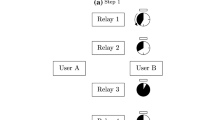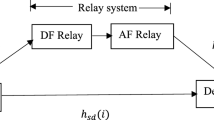Abstract
In this paper, we propose two differential relaying strategies; Active User Strategy (AUS) and Passive Users Relaying Strategy (PURS), which could be used by the base-station to transmit data of two users over downlink channels in a two-user cooperative communication network. Differential schemes are used so the users do not require the knowledge of channel gains for decoding of their data. The performance of both schemes is evaluated for the decode-and-forward, selection relaying, and incremental relaying protocols. For the decode-and-forward protocol, the performance heavily depends upon the signal-to-noise ratio (SNR) of the link between source and relay. We propose a conditional probability of error based approach, which can be used to regulate the erroneous relaying of data. Both AUS and PURS are able to achieve performance gains as compared to the direct transmission differential scheme in the case of selection relaying and incremental relaying protocols at high SNRs. The proposed schemes perform better than their counterpart of the amplify-and-forward differential relaying proposed previously.
Similar content being viewed by others

References
Gastpar, M., & Vetterli, M. (2002). On the capacity of wireless networks: The relay case. In IEEE conference on computer communications (INFOCOM), New York, USA (pp. 1577–1586).
Himsoon T., Su W., Liu K.J.R. (2006) Differential transmission for amplify-and-forward cooperative communications. IEEE Signal Processing Letters 12(9): 597–600
Hunter, T. E., & Nosratinia, A. (2002). Cooperation diversity through coding. In IEEE international symposium on information theory (ISIT) (p. 220). Lausanne, Switzerland: Palais de Beaulieu.
Hwang C.S., Nam S.H., Chung J., Tarokh V. (2003) Differential space time block codes using nonconstant modulus constellations. IEEE Transactions on Signal Processing 51(11): 2955–2964
Laneman J.N., Tse D.N.C., Wornell G.W. (2004) Cooperative diversity in wireless networks: Efficient protocol and outage behaviour. IEEE Transactions on Information Theory 50(12): 3062–3080
Li H., Zhao Q. (2006) Distributed modulation for cooperative wireless communications. IEEE Signal Processing Magazine 23(5): 30–36
Nosratinia A., Hunter T.E., Hedayat A. (2004) Cooperative communication in wireless networks. IEEE Communications Magazine 42: 74–80
Proakis J.G. (2001) Digital communication (4th ed). McGraw Hill, New York, USA
Sendonaris, A., Erkip, E., & Aazhang, B. (1998). Increasing uplink capacity via user cooperation diversity. In IEEE international symposium on information theory (ISIT), Cambridge, MA (p. 156).
Sendonaris A., Erkip E., Aazhang B. (2003) User cooperation diversity—part I: System description. IEEE Transactions on Communications 51(11): 1927–1938
Simon M.K., Alouini M.S. (2005) Digital communication over fading channels. Willey, New York, USA
Tarasak P., Minn H., Bhargava V.K. (2006) Differential modulation for two-user cooperative diversity systems. IEEE Journal on Selected Areas in Commnunications 23(9): 1891–1900
Zhao Q., Li H. (2005) Performance of differential modulation with wireless relays in Rayleigh fading channels. IEEE Communications Letters 9(4): 343–345
Author information
Authors and Affiliations
Corresponding author
Rights and permissions
About this article
Cite this article
Bhatnagar, M.R., Hjørungnes, A. Differential Relay Strategies Over Downlink Channel in Two-User Cooperative Communication System. Wireless Pers Commun 53, 1–14 (2010). https://doi.org/10.1007/s11277-009-9666-7
Received:
Accepted:
Published:
Issue Date:
DOI: https://doi.org/10.1007/s11277-009-9666-7



